The AMD Ryzen 3 1300X and Ryzen 3 1200 CPU Review: Zen on a Budget
by Ian Cutress on July 27, 2017 9:30 AM EST- Posted in
- CPUs
- AMD
- Zen
- Ryzen
- Ryzen 3
- Ryzen 3 1300X
- Ryzen 3 1200
Benchmarking Performance: CPU System Tests
Our first set of tests is our general system tests. These set of tests are meant to emulate more about what people usually do on a system, like opening large files or processing small stacks of data. This is a bit different to our office testing, which uses more industry standard benchmarks, and a few of the benchmarks here are relatively new and different.
All of our benchmark results can also be found in our benchmark engine, Bench.
PDF Opening
First up is a self-penned test using a monstrous PDF we once received in advance of attending an event. While the PDF was only a single page, it had so many high-quality layers embedded it was taking north of 15 seconds to open and to gain control on the mid-range notebook I was using at the time. This put it as a great candidate for our 'let's open an obnoxious PDF' test. Here we use Adobe Reader DC, and disable all the update functionality within. The benchmark sets the screen to 1080p, opens the PDF to in fit-to-screen mode, and measures the time from sending the command to open the PDF until it is fully displayed and the user can take control of the software again. The test is repeated ten times, and the average time taken. Results are in milliseconds.
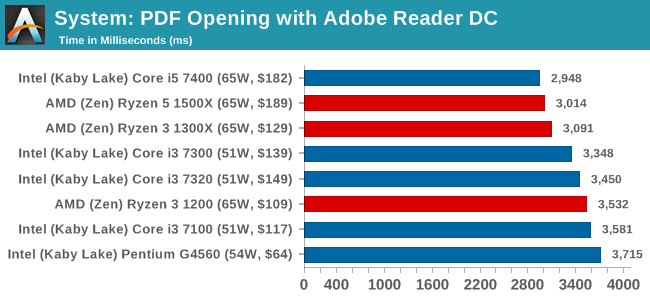
FCAT Processing: link
One of the more interesting workloads that has crossed our desks in recent quarters is FCAT - the tool we use to measure stuttering in gaming due to dropped or runt frames. The FCAT process requires enabling a color-based overlay onto a game, recording the gameplay, and then parsing the video file through the analysis software. The software is mostly single-threaded, however because the video is basically in a raw format, the file size is large and requires moving a lot of data around. For our test, we take a 90-second clip of the Rise of the Tomb Raider benchmark running on a GTX 980 Ti at 1440p, which comes in around 21 GB, and measure the time it takes to process through the visual analysis tool.
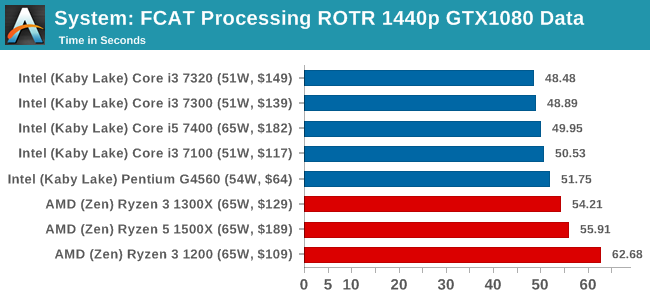
Dolphin Benchmark: link
Many emulators are often bound by single thread CPU performance, and general reports tended to suggest that Haswell provided a significant boost to emulator performance. This benchmark runs a Wii program that ray traces a complex 3D scene inside the Dolphin Wii emulator. Performance on this benchmark is a good proxy of the speed of Dolphin CPU emulation, which is an intensive single core task using most aspects of a CPU. Results are given in minutes, where the Wii itself scores 17.53 minutes.
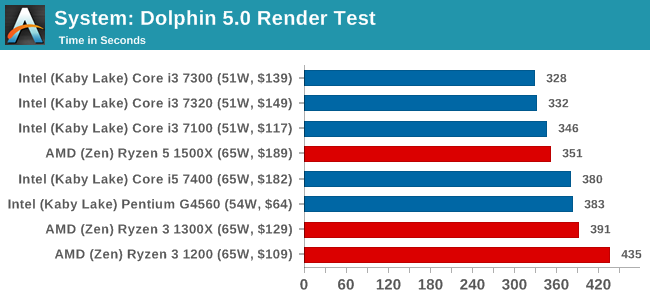
3D Movement Algorithm Test v2.1: link
This is the latest version of the self-penned 3DPM benchmark. The goal of 3DPM is to simulate semi-optimized scientific algorithms taken directly from my doctorate thesis. Version 2.1 improves over 2.0 by passing the main particle structs by reference rather than by value, and decreasing the amount of double->float->double recasts the compiler was adding in. It affords a ~25% speed-up over v2.0, which means new data.
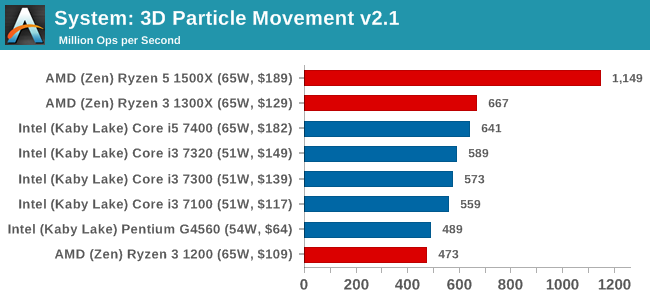
DigiCortex v1.20: link
Despite being a couple of years old, the DigiCortex software is a pet project for the visualization of neuron and synapse activity in the brain. The software comes with a variety of benchmark modes, and we take the small benchmark which runs a 32k neuron/1.8B synapse simulation. The results on the output are given as a fraction of whether the system can simulate in real-time, so anything above a value of one is suitable for real-time work. The benchmark offers a 'no firing synapse' mode, which in essence detects DRAM and bus speed, however we take the firing mode which adds CPU work with every firing.
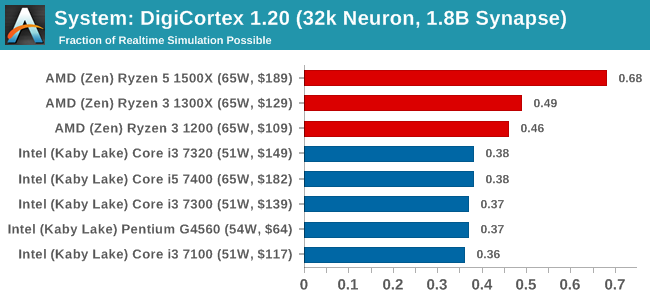
Agisoft Photoscan 1.0: link
Photoscan stays in our benchmark suite from the previous version, however now we are running on Windows 10 so features such as Speed Shift on the latest processors come into play. The concept of Photoscan is translating many 2D images into a 3D model - so the more detailed the images, and the more you have, the better the model. The algorithm has four stages, some single threaded and some multi-threaded, along with some cache/memory dependency in there as well. For some of the more variable threaded workload, features such as Speed Shift and XFR will be able to take advantage of CPU stalls or downtime, giving sizeable speedups on newer microarchitectures.
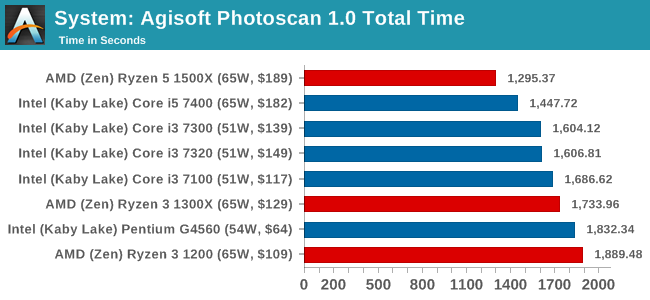










140 Comments
View All Comments
wallysb01 - Thursday, July 27, 2017 - link
And you're an N=1. Intel iGPUs are more than enough for plenty uses now, and have been for a while actually. I built a cheap office machine for my wife that we use also use for streaming, for example, I even played some DOTA on it for a time. That computer has the G3220 and it works just fine. HTPC, office/web, even a little light/cheap gaming... Intel iGPU is all you need. The extra $50+, power use and space (for those that want small form factors) for a dGPU is just thrown in the garbage and lit on fire for most computer use.DanGer1 - Saturday, July 29, 2017 - link
If you want to compare to an APU you will have to wait for Raven Ridge and I am pretty sure we all know what integrated Radeon graphics compare to Intel....no contest. It is my understanding that Raven Ridge will be coming out on 14nm+ as well. AMD will have a clear win in this segment.KAlmquist - Thursday, July 27, 2017 - link
Currently, the lowest priced AM4 motherboard on Newegg is the ASRock A320M-HDV for $55 including shipping. There are a number of Intel LGA 1151 boards for less than that, starting with the GIGABYTE GA-H110M-M.2 for $48 and the ASRock H110M-HDS R3.0 for $51. So motherboard costs currently favor Intel at the low end. That said, the price differential is small, and may disappear over time as manufacturers recover their development costs.DanGer1 - Saturday, July 29, 2017 - link
Right, but you can overclock the R3 without needing to by a "K" and it comes with a cooler.SlowSpyder - Thursday, July 27, 2017 - link
Looks like AMD aimed for the i5 7400, but priced it with the i3's. Not much to complain about here.Otritus - Thursday, July 27, 2017 - link
The third(last) chart on the first page is listed as Comparison: AMD Ryzen 3 1300X when it should be Comparison: AMD Ryzen 3 1200Otritus - Thursday, July 27, 2017 - link
On the second page it says fury x uses hdm not hbmDrake H. - Thursday, July 27, 2017 - link
just missed the dolphin...rocky12345 - Thursday, July 27, 2017 - link
Great review thank you.After watching a review on YT from AdoredTV and reading your review here I feel the R3 Ryzen's are pretty much what we all expected. They beat that useless Pentium CPU and duke it out with the i3's and the non K i5's. On AdoredTV he got the 1200 to 3.9Ghz and the 1300x to 4.0Ghz on the stock coolers with good temps. Once overclocked they really show their value in everything more so in the games. They both make the useless Pentium and the i3's look pretty sad.
Another thing to look at is the R3's come with a stock cooler and are unlocked as well right their that adds value because unlike a K CPU you do not need to buy a cooler and if you get a Intel non K you can't make them faster by overclocking the Intel CPU's.
rocky12345 - Thursday, July 27, 2017 - link
Made a mistake it is Hardware Unboxed not AdoredTV I was referring to in my first comment. My bad sorry.